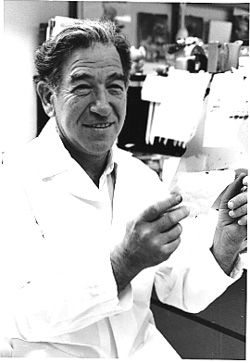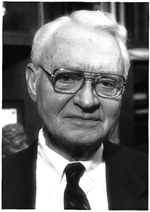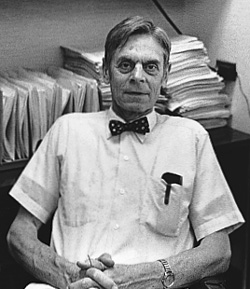
Stanley Cohen, Ph.D.
Great researchers

William J. Darby, Ph.D.

Dr. Charles "Rollo" Park
Sidney P. Colowick, Ph.D.
(1916-1985)
VUSM faculty years (1959-1985)
In a memorial tribute to Sidney P. Colowick, Ph.D., his friend and colleague Nathan O. Kaplan, Ph.D., described him as “the foremost representative of American-born biochemists who made modern biochemistry an ‘American discipline’.”
Colowick, who was the American Cancer Society-Charles Hayden Foundation Professor of Microbiology, is known principally for his work on an enzyme called hexokinase and the regulation of sugar transport in cultured animal cells. He made fundamental contributions to understanding how cells derive energy from the metabolism of carbohydrates and the enzymes involved in the early steps of sugar metabolism.
Together with Kaplan, he planned and edited the first six volumes of Methods in Enzymology, launching in 1955 what became a series of well-known and useful handbooks.
Colowick joined the Vanderbilt faculty as an American Cancer Society Professor with research support from the society until the end of his career. With Dr. Rollo Park, Colowick attracted Dr. Earl Sutherland and other outstanding scientists to Vanderbilt, establishing the institution as a world leader in the field of regulatory biology.
Colowick was elected to the National Academy of Sciences in 1972.
Dr. Ernest W. Goodpasture
(1886-1960)
VUSM faculty years (1924-1960)
Viruses and chicken eggs made Dr. Ernest W. Goodpasture famous. In 1931, Goodpasture, professor of Pathology, developed the first practical method for cultivating large quantities of a virus in the laboratory—by growing it in the exposed membrane of a chick embryo.
“It revolutionized the study of viruses and viral diseases,” said Collins, one of Goodpasture’s students. “Scientists from all over the world came here to learn the technique.”
The method opened the door for research that probed the nature of viruses and led to the development of vaccines to protect against viral diseases.
Goodpasture was most proud of his discovery of the cause of mumps, which had eluded investigators since ancient times. In a series of experiments using monkeys, he proved the viral nature of the disease.
Goodpasture was one of the first choices in a drive to expand the School of Medicine faculty to one distinguished in American medical education and research. Among his many honors, Goodpasture was elected to the National Academy of Sciences in 1937 and the American Philosophical Society in 1943.
Lubomir S. Hnilica, Ph.D.
(1929-1986)
VUSM faculty years (1975-1986)
Lubomir S. Hnilica, Ph.D., was considered an international authority on the effects of chemical carcinogens on nuclear proteins, before he died in 1986. He made many basic pioneering observations related to the biochemistry of chromosomal proteins.
His early work focused on the chromosomal proteins called histones and laid the foundation for the purification of histone proteins in large quantities for further characterization. Hnilica’s research suggested that cancer-causing chemicals change the nature and amount of histone proteins, revealing the site where cancer cells suffer DNA damage.
Hnilica, professor of Biochemistry and Mary Geddes Stahlman Professor of Cancer Research, was also interested in other non-histone chromosomal proteins and their changes during chemical carcinogenesis and spontaneous human malignancies.
Hnilica served as the Associate Director for Research for the Vanderbilt University Cancer Research and Treatment Center—the predecessor of today’s Vanderbilt-Ingram Cancer Center. He received the Vanderbilt University Earl Sutherland Prize for Achievement in Research in 1986.
Dr. Grant W. Liddle (1921-1989)
VUSM faculty years (1956-1989)
An inherited form of hypertension, pseudoaldosteronism, today is called Liddle’s syndrome in honor of the man who first characterized the disease and discovered that it could be controlled with medication.
Dr. Grant W. Liddle, professor of Medicine and chair of Medicine from 1968 to 1983, was internationally recognized for his pioneering research in clinical endocrinology.
Focusing especially on the physiology of the pituitary and adrenal glands, he was able to clarify the role of the pituitary in Cushing’s disease, and he developed improved methods for the treatment of the disease. He discovered that non-endocrine sites could produce the hormone ACTH (ectopic ACTH syndrome), causing Cushing’s syndrome.
Liddle was the first to show that metyrapone, an adrenal enzyme inhibitor, suppresses cortisol production and elicits a compensatory increase in pituitary gland ACTH secretion. He used the finding to devise practical tests of pituitary and adrenal gland function.
He was also the first to study the aldosterone antagonist, spironolactone, which promotes sodium loss and is clinically useful to treat effects of aldosteronism like edema and hypertension.
Liddle received Vanderbilt’s Sutherland Prize in 1979 and became a member of the National Academy of Sciences in 1981.
Dr. Earl W. Sutherland Jr.
(1915-1974)
VUSM faculty years (1963-1973)
Dr. Earl W. Sutherland opened the black box that concealed the secrets of hormone action.
In studying how adrenaline causes liver cells to convert glycogen to glucose, Sutherland discovered a previously unknown substance—cyclic AMP—that occurred as an intermediate in the process.
Sutherland, professor of Physiology, proposed a general scheme for hormone action in which hormones interact with receptors on the cell surface. These receptors, he contended, then pass the signal along to an enzyme that manufactures cyclic AMP intracellularly where it activates or inhibits various metabolic processes. He called cyclic AMP the “second messenger” (the hormone was the first messenger). His scheme, now including multiple different “second messenger” compounds, remains an accurate description of how hormones work.
Sutherland became a member of the National Academy of Sciences in 1966 and won the 1971 Nobel Prize in Physiology or Medicine for “his discoveries concerning the mechanisms of the action of hormones.”
Stanley Cohen, Ph.D. (1922- )
VUSM faculty years (1959-present)
When Stanley Cohen, Ph.D. injected salivary gland extract into newborn mice, he noticed a strange acceleration of development—their eyes opened and teeth erupted earlier than usual. This keen observation led Cohen to discover the substance epidermal growth factor (EGF), so named because it stimulated the growth of epithelial cells in the cornea and skin.
Cohen had previously, with Rita Levi-Montalcini, isolated a nerve growth factor (NGF) that she had discovered in certain mouse tumors. The two shared the 1986 Nobel Prize in Physiology or Medicine for their “discoveries of growth factors.”
Cohen’s isolation of EGF and determination of its amino acid sequence provided scientists for the first time with a factor that allowed studies of the cell growth process. Cohen continued to study EGF, its interaction with cell surface receptors, and the intracellular signaling pathways activated by the growth factor.
Cohen’s work laid the foundation for the study of growth factors and the mechanisms regulating the growth and survival of cells, of critical importance to cancer research.
Cohen, now Distinguished Professor of Biochemistry, Emeritus, received Vanderbilt’s Sutherland Prize in 1977, was elected to the National Academy of Sciences in 1980, and received both the Nobel Prize and the Albert Lasker Basic Medical Research Award in 1986.
William J. Darby, M.D., Ph.D.
(1913- )
VUSM faculty years (1944-present)
Not many biochemists have the opportunity to conduct research all over the world. But Dr. William J. Darby, an internationally renowned expert in nutritional science, traveled around the globe to conduct studies that have shaped international nutrition education and assistance programs. Darby, currently professor of Biochemistry, Emeritus, served as chair of the department from 1949-1971.
Darby’s early research with Dr. Paul L. Day led to the discovery of vitamin M, now called folic acid, and his subsequent studies defined the roles of folic acid, Vitamin C, and Vitamin B12 in metabolism.
Darby and his colleagues at Vanderbilt were the first to demonstrate the ability of folic acid to combat the anemia and gastrointestinal dysfunction in tropical sprue. A Vanderbilt study evaluating the nutritional status of infants, children, and pregnant women set the standards for assessing nutritional status and led to a series of nutritional surveys all over the world.
Some of Darby’s global research included studies in the Middle East and Africa that defined zinc deficiency and characterized the effects of parasites on nutrition.
The application of Darby’s research and his personal involvement in advisory committees has influenced all of the major national and international agencies that have responsibilities in nutrition.
Darby became a member of the National Academy of Sciences in 1972.
Dr. Charles R. “Rollo” Park
(1916- )
VUSM faculty years (1952-present)
Dr. Charles R. “Rollo” Park once said in an interview that he thought his main contribution to Vanderbilt was putting together a department focused on the study of metabolic problems, particularly diabetes, that in its concentration of effort and interest has “trained many people who are well-known in diabetes circles.”
Park, Professor of Physiology, Emeritus and chair of Physiology from 1952 to 1984, is no stranger in diabetes circles. His career-long studies of carbohydrate metabolism, insulin action, and glucose utilization have greatly contributed to knowledge about diabetes.
Park demonstrated that insulin acts by promoting the transport of glucose (sugar) across the muscle cell membrane, and he subsequently found evidence for both an insulin receptor site and a glucose carrier site in the cell membrane.
With colleagues at Vanderbilt, Park developed quantitative analytical methods to measure the various substances produced during glucose metabolism. They were the first to identify the role of the hormone glucagon in stimulating gluconeogenesis—the production of glucose by the liver.
Park is credited with the selection of Vanderbilt University for the establishment of the first Diabetes and Endocrinology Research Center in 1973. He was elected to the National Academy of Sciences in 1980 and awarded Vanderbilt’s Sutherland Prize in 1984.
*Special thanks to Mary Teloh, special collections librarian, Eskind Biomedical Library, for providing historical data and photographs.













